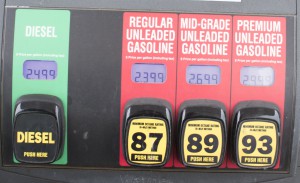
The only difference between regular octane and premium octane gasoline for most vehicles is the price.
With automakers doing all they can these days to deliver more power from smaller and more fuel-efficient engines, it seems the easiest thing to do to help that along is to give your car, truck or SUV “the good stuff,” when you fill up, right?
Wrong. Using higher octane fuel for your vehicle, if it doesn’t require it, does not net any substantive increase in horsepower or improvement in mileage or emissions, according to a new AAA study.
In essence, all you’re doing is throwing away perfectly good money you could spend elsewhere as the average price per gallon for premium gasoline is as much as 25% more than regular. It may not sound like much, but with the U.S. average hovering around $2.46 for regular and $3.01 for premium, you’re talking about between $7 and $10 on an average fill up.
The costs add up nationally as the 16.5 million drivers unnecessarily used premium gasoline in their vehicle more than 270 million times in the past year, at a cost of $2.1 billion, AAA notes. A better option, according to AAA’s studies, would be to use a fuel that meets “Top Tier” standards, which results in 19 times fewer engine deposits. Such deposits decrease vehicle performance and reduce fuel economy.
(Fuel economy of new vehicles continues to drop. To find out why, Click Here.)
“Drivers see the ‘premium’ name at the pump and may assume the fuel is better for their vehicle,” said John Nielsen, AAA’s managing director of Automotive Engineering and Repair. “AAA cautions drivers that premium gasoline is higher octane, not necessarily higher quality.”
Some high-performance engines are specifically designed to operate on premium fuel and need the higher octane. Vehicles designed to run on regular gasoline cannot take advantage of the higher octane rating or produce more horsepower using premium fuel.
Gasoline octanes come in three different ratings for automobiles: 87 (regular), 89 (mid-grade) and 91/93 (premium). Most vehicles are rated to use 87.
(Click Here to see why Greensboro, N.C. is the best place to drive and why Honolulu is the worst.)
Approximately 70% U.S. drivers currently own a vehicle that requires regular gasoline, while 16% drive vehicles that require premium fuel. The remaining 10% own a vehicle that requires mid‐grade gasoline while the remaining 4% use an alternate fuel source (i.e. electricity).
Many drivers believe “premium” is better, but really the octane rating – and the name associated with that particular gasoline – is only a measurement of that fuel’s resistance to “knock,” or burning before it’s intended to.
Higher levels of octane allow engines to run at higher compression ratios without knocking. The higher compression ratios, in turn, lead to more energy when the fuel ignites in the cylinder. This is most often associated with engines in sports cars.
(Transportation eclipses power generation as leading cause of pollution. Click Here for the story.)
As part of its study, AAA enlisted the Auto Club of California to test six vehicles: a 3.5-liter Ecoboost Ford F-150, 6.2-liter V8 Cadillac Escalade, 5.0-liter Ford Mustang V8; and four-cylinder engines in a 2.0-liter Mazda MX-5 Miata, 1.8-liter Audi A3 and 1.4-liter Jeep Renegade.
